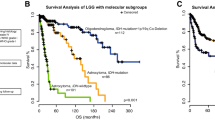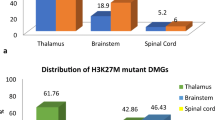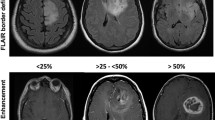Abstract
Purpose
The rarity of IDH2 mutations in supratentorial gliomas has led to gaps in understanding their radiological characteristics, potentially resulting in misdiagnosis based solely on negative IDH1 immunohistochemical staining. We aimed to investigate the clinical and imaging characteristics of IDH2-mutant gliomas.
Methods
We analyzed imaging data from adult patients with pathologically confirmed diffuse lower-grade gliomas and known IDH1/2 alteration and 1p/19q codeletion statuses obtained from the records of our institute (January 2011 to August 2022, Cohort 1) and The Cancer Imaging Archive (TCIA, Cohort 2). Two radiologists evaluated clinical information and radiological findings using standardized methods. Furthermore, we compared the data for IDH2-mutant and IDH-wildtype gliomas. Multivariate logistic regression was used to identify the predictors of IDH2 mutation status, and receiver operating characteristic curve analysis was employed to assess the predictive performance of the model.
Results
Of the 20 IDH2-mutant supratentorial gliomas, 95% were in the frontal lobes, with 75% classified as oligodendrogliomas. Age and the T2-FLAIR discordance were independent predictors of IDH2 mutations. Receiver operating characteristic curve analysis for the model using age and T2-FLAIR discordance demonstrated a strong potential for discriminating between IDH2-mutant and IDH-wildtype gliomas, with an area under the curve of 0.96 (95% CI, 0.91–0.98, P = .02).
Conclusion
A high frequency of oligodendrogliomas with 1p/19q codeletion was observed in IDH2-mutated gliomas. Younger age and the presence of the T2-FLAIR discordance were associated with IDH2 mutations and these findings may help with precise diagnoses and treatment decisions in clinical practice.




Similar content being viewed by others
Data Availability
Data supporting the results of this study are not publicly available, but are available from the corresponding author upon reasonable request.
Change history
29 April 2024
A Correction to this paper has been published: https://doi.org/10.1007/s00234-024-03369-0
Abbreviations
- IDH :
-
Isocitrate dehydrogenase
- IHC:
-
Immunohistochemical
- LrGGs:
-
Lower-grade gliomas
References
Louis DN, Perry A, Wesseling P et al (2021) The 2021 WHO classification of tumors of the central nervous system: A summary. Neuro Oncol 23:1231–1251
Mellinghoff IK, van den Bent MJ, Blumenthal DT et al (2023) Vorasidenib in IDH1- or IDH2-mutant low-grade glioma. N Engl J Med. https://doi.org/10.1056/NEJMoa2304194
Ward PS, Lu C, Cross JR et al (2013) The potential for isocitrate dehydrogenase mutations to produce 2-hydroxyglutarate depends on allele specificity and subcellular compartmentalization. J Biol Chem 288:3804–3815
Gross S, Cairns RA, Minden MD et al (2010) Cancer-associated metabolite 2-hydroxyglutarate accumulates in acute myelogenous leukemia with isocitrate dehydrogenase 1 and 2 mutations. J Exp Med 207:339–344
Appay R, Tabouret E, Macagno N et al (2018) IDH2 mutations are commonly associated with 1p/19q codeletion in diffuse adult gliomas. Neuro Oncol 20:716–718
Wang HY, Tang K, Liang TY et al (2016) The comparison of clinical and biological characteristics between IDH1 and IDH2 mutations in gliomas. J Exp Clin Cancer Res 35:86
Nishikawa T, Watanabe R, Kitano Y et al (2022) Reliability of IDH1-R132H and ATRX and/or p53 immunohistochemistry for molecular subclassification of Grade 2/3 gliomas. Brain Tumor Pathol 39:14–24
Kamble AN, Agrawal NK, Koundal S et al (2023) Imaging-based stratification of adult gliomas prognosticates survival and correlates with the 2021 WHO classification. Neuroradiology 65:41–54
Park YW, Han K, Ahn SS et al (2018) Prediction of IDH1-mutation and 1p/19q-codeletion status using preoperative MR imaging phenotypes in lower grade gliomas. AJNR Am J Neuroradiol 39:37–42
Wu CC, Jain R, Radmanesh A et al (2018) Predicting genotype and survival in glioma using standard clinical MR imaging apparent diffusion coefficient images: A pilot study from the cancer genome atlas. AJNR Am J Neuroradiol 39:1814–1820
Hyare H, Rice L, Thust S et al (2019) Modelling MR and clinical features in grade II/III astrocytomas to predict IDH mutation status. Eur J Radiol 114:120–127
Maynard J, Okuchi S, Wastling S et al (2021) World health organization grade II/III glioma molecular status: Prediction by MRI morphologic features and apparent diffusion coefficient. Radiology 298:E61
Lasocki A, Buckland ME, Drummond KJ et al (2022) Conventional MRI features can predict the molecular subtype of adult grade 2–3 intracranial diffuse gliomas. Neuroradiology 64:2295–2305
Li M, Ren X, Chen X et al (2022) Combining hyperintense FLAIR rim and radiological features in identifying IDH mutant 1p/19q non-codeleted lower-grade glioma. Eur Radiol 32:3869–3879
Li M, Wang J, Chen X et al (2022) The sinuous, wave-like intratumoral-wall sign is a sensitive and specific radiological biomarker for oligodendrogliomas. Eur Radiol. https://doi.org/10.1007/s00330-022-09314-0
Malik P, Soliman R, Chen YA et al (2024) Patterns of T2-FLAIR discordance across a cohort of adult-type diffuse gliomas and deviations from the classic T2-FLAIR mismatch sign. Neuroradiology. https://doi.org/10.1007/s00234-024-03297-z
Poetsch L, Bronnimann C, Loiseau H et al (2021) Characteristics of IDH-mutant gliomas with non-canonical IDH mutation. J Neurooncol 151:279–286
Visani M, Acquaviva G, Marucci G et al (2017) Non-canonical IDH1 and IDH2 mutations: a clonal and relevant event in an Italian cohort of gliomas classified according to the 2016 World Health Organization (WHO) criteria. J Neurooncol 135:245–254
Yan J, Zhang S, Sun Q et al (2022) Predicting 1p/19q co-deletion status from magnetic resonance imaging using deep learning in adult-type diffuse lower-grade gliomas: a discovery and validation study. Lab Invest 102:154–159
Calabrese E, Villanueva-Meyer JE, Rudie JD et al (2022) The University of California San Francisco preoperative diffuse glioma MRI dataset. Radiol Artif Intell 4:e220058
Patel SH, Poisson LM, Brat DJ et al (2017) T2-FLAIR mismatch, an imaging biomarker for IDH and 1p/19q status in lower-grade gliomas: A TCGA/TCIA project. Clin Cancer Res 23:6078–6085
Juratli TA, Tummala SS, Riedl A et al (2019) Radiographic assessment of contrast enhancement and T2/FLAIR mismatch sign in lower grade gliomas: correlation with molecular groups. J Neurooncol 141:327–335
Patel SH, Batchala PP, Mrachek EKS et al (2020) MRI and CT Identify Isocitrate Dehydrogenase (IDH)-mutant lower-grade gliomas misclassified to 1p/19q codeletion status with fluorescence in Situ hybridization. Radiology 294:160–167
Makino Y, Arakawa Y, Yoshioka E et al (2021) Prognostic stratification for IDH-wild-type lower-grade astrocytoma by Sanger sequencing and copy-number alteration analysis with MLPA. Sci Rep 11:14408
Ceccarelli M, Barthel FP, Malta TM et al (2016) Molecular profiling reveals biologically discrete subsets and pathways of progression in Diffuse Glioma. Cell 164:550–563
Kline CN, Joseph NM, Grenert JP et al (2017) Targeted next-generation sequencing of pediatric neuro-oncology patients improves diagnosis, identifies pathogenic germline mutations, and directs targeted therapy. Neuro Oncol 19:699–709
Jenkinson MD, du Plessis DG, Smith TS, Joyce KA, Warnke PC, Walker C (2006) Histological growth patterns and genotype in oligodendroglial tumours: correlation with MRI features. Brain 129:1884–1891
Megyesi JF, Kachur E, Lee DH et al (2004) Imaging correlates of molecular signatures in oligodendrogliomas. Clin Cancer Res 10:4303–4306
Darlix A, Deverdun J, Menjot de Champfleur N et al (2017) IDH mutation and 1p19q codeletion distinguish two radiological patterns of diffuse low-grade gliomas. J Neurooncol 133:37–45
Kwon MJ, Kang SY, Cho H, Lee JI, Kim ST, Suh YL (2020) Clinical relevance of molecular subgrouping of gliomatosis cerebri per 2016 WHO classification: a clinicopathological study of 89 cases. Brain Pathol 30:235–245
Jain R, Johnson DR, Patel SH et al (2020) “Real world” use of a highly reliable imaging sign: “T2-FLAIR mismatch” for identification of IDH mutant astrocytomas. Neuro Oncol 22:936–943
Johnson DR, Kaufmann TJ, Patel SH, Chi AS, Snuderl M, Jain R (2019) There is an exception to every rule-T2-FLAIR mismatch sign in gliomas. Neuroradiology 61:225–227
Pinto C, Noronha C, Taipa R, Ramos C (2022) T2-FLAIR mismatch sign: a roadmap of pearls and pitfalls. Br J Radiol 95:20210825
Lee MD, Patel SH, Mohan S et al (2023) Association of partial T2-FLAIR mismatch sign and isocitrate dehydrogenase mutation in WHO grade 4 gliomas: results from the ReSPOND consortium. Neuroradiology 65:1343–1352
Deguchi S, Oishi T, Mitsuya K et al (2020) Clinicopathological analysis of T2-FLAIR mismatch sign in lower-grade gliomas. Sci Rep 10:10113
Yamashita S, Takeshima H, Kadota Y et al (2022) T2-fluid-attenuated inversion recovery mismatch sign in lower grade gliomas: correlation with pathological and molecular findings. Brain Tumor Pathol 39:88–98
Wesseling P, van den Bent M, Perry A (2015) Oligodendroglioma: pathology, molecular mechanisms and markers. Acta Neuropathol 129:809–827
Lasocki A, Buckland ME, Molinaro T et al (2023) Correlating MRI features with additional genetic markers and patient survival in histological grade 2–3 IDH-mutant astrocytomas. Neuroradiology. https://doi.org/10.1007/s00234-023-03175-0
Funding
This work was supported by JSPS KAKENHI Grant Number 22K07746, 21K15826,
Author information
Authors and Affiliations
Corresponding author
Ethics declarations
Conflict of interest
The authors have no relevant financial or non-financial interests to disclose.
Ethical approval
Institutional Review Board approval was obtained. This study was performed in line with the principles of the Declaration of Helsinki. Approval was granted by Kyoto University Graduate School and Faculty of Medicine, Ethics Committee (G1124, R2088,R3262).
Informed consent
The requirement for informed consent was waived by the Institutional Review Board.
Additional information
Publisher's Note
Springer Nature remains neutral with regard to jurisdictional claims in published maps and institutional affiliations.
Data Citations
1. Calabrese E, Villanueva-Meyer J, Rudie J, et al. The University of California San Francisco Preoperative Diffuse Glioma MRI (UCSF-PDGM). https://doi.org/10.7937/TCIA.BDGF-8V37.
2. Pedano N, Flanders AE, Scarpace L, et al. The Cancer Genome Atlas Low Grade Glioma Collection (TCGA-LGG). https://doi.org/10.7937/K9/TCIA.2016.L4LTD3TK.
The original online version of this article was revised: The original article contains a spelling error in the article title. The word “slioma” should be corrected to “glioma”. The corrected article title should read “Clinical and imaging characteristics of supratentorial glioma with IDH2 mutation
Rights and permissions
Springer Nature or its licensor (e.g. a society or other partner) holds exclusive rights to this article under a publishing agreement with the author(s) or other rightsholder(s); author self-archiving of the accepted manuscript version of this article is solely governed by the terms of such publishing agreement and applicable law.
About this article
Cite this article
Ikeda, S., Sakata, A., Arakawa, Y. et al. Clinical and imaging characteristics of supratentorial glioma with IDH2 mutation. Neuroradiology (2024). https://doi.org/10.1007/s00234-024-03361-8
Received:
Accepted:
Published:
DOI: https://doi.org/10.1007/s00234-024-03361-8




